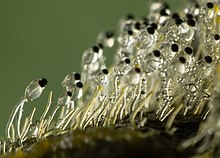| Pilobolus crystallinus | |
|---|---|

| |
| Pilobolus crystallinus sporangia | |
| Scientific classification | |
| Domain: | Eukaryota |
| Kingdom: | Fungi |
| Division: | Mucoromycota |
| Class: | Mucoromycetes |
| Order: | Mucorales |
| Family: | Pilobolaceae |
| Genus: | Pilobolus |
| Species: | P. crystallinus
|
| Binomial name | |
| Pilobolus crystallinus (F.H.Wigg.) Tode (1784)
| |
Pilobolus crystallinus, commonly known as the "dung cannon" or "hat thrower", is a species of fungus belonging to the Mucorales order. It is unique in that it adheres its spores to vegetation, so as to be eaten by grazing animals. It then passes through the animals' digestive systems and grows in their feces. Although these fungi only grow to be 2–4 cm (0.8–1.6 in) tall, they can shoot their sporangium, containing their spores, up to 2 m (6.6 ft) away. Due to an increase of pressure in the vesicle, the sporangium can accelerate 0–45 mph in the first millimeter of its flight, which corresponds to an acceleration of 20000 g. Using a mucus-like substance found in the vesicle of the fungus, the sporangium can adhere itself onto whatever it lands, thus completing its life cycle.
The basionym of this species is Hydrogera crystallina F.H. Wigg. 1780.
The ability of this fungus to cause problems for florists was noted in the scientific literature in 1881:
... this small fungus had proved this season to be an expensive annoyance to florists engaged in winter forcing flowers. Rose-growers especially had found it to interfere seriously with their profits. The injury was caused by the projection of the sporangia which covered the flowers and leaves of the roses as if profusely dusted with black pepper. The flowers were almost unsaleable as the first impression was that the black dots were aphids.[1]